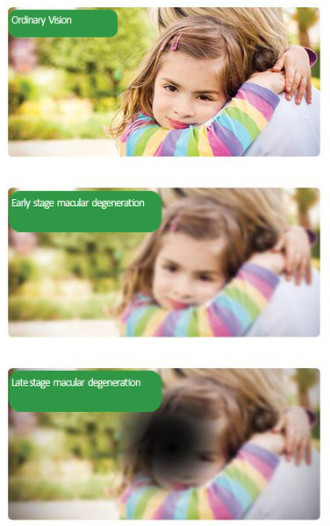Macular Degeneration
The risk of developing macular degeneration increases with age. Less than 1% of people under 65 have late-stage MD. But, over 20% of people are affected by it by the age of 90.
Age related macular degeneration or AMD is the most common cause of sight loss in the UK. More then 500,000 in the UK alone have AMD and about 250,000 people are registered as visually impared. Because we are living longer, the number of people affected by AMD is constantly increaseing.
What is Age-related Macular Degeneration?
The macula is a small part of the retina responsible for all of our central vision, most of our colour vision and the fine detail of what we see. AMD is caused in two very different ways.
The first is wet macular degeneration which is caused when tiny abnormal blood vessels form behind the retina and towards the macula. These vessels leak blood or fluid which scars the macula and leads to rapid loss of central vision. As this kind of MD develops so quickly, fast referral and treatment is of up-most importance.
The second is dry macular degeneration which is a more gradual deterioration of the macula over many years which is caused when the cells of the macula gradually die off over time as you age and are not regenerated. The term 'dry' doesn't mean the person will have dry eyes, just that the condition is not caused becasue of any fluid like in wet AMD.
10 to 15% of people with dry AMD can also then develop wet AMD because new blood vessels try to grow but in turn actually harm the macula. If you have dry AMD and notice a rapid change in vision it is vital you get an appointment with your optmetrist.
Also is MD occurs in one eye there is a possibility that it may also affect your other eye within a few years but this veries from person to person.
While AMD causes central vision loss and can be devestating, it is important to remember it will not lead to complete blindness. You will still have your remaining peripheral vision.
Symptoms
AMD affect people in different ways and these may include -
- Straight lines being distorted and appearing bent.
- Your vision my become blurry or develop gaps.
- Colours may seem very faded or washed out.
- Objects in front of you may seem to move, distort or disappear.
- Dark spots could appear in your vision.
- You may have a difficulty seeing in bright sunlight.
- You may have problems adapting from dark to light environments or vica versa.
- And while reading at your normal reading distance, words may disappear.



